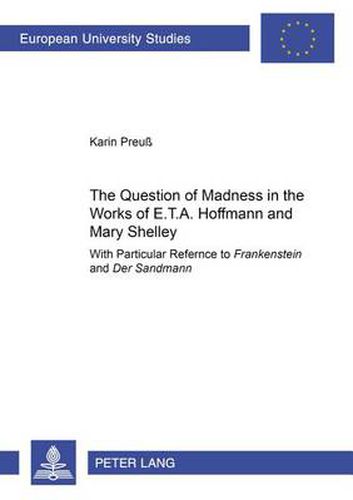Readings Newsletter
Become a Readings Member to make your shopping experience even easier.
Sign in or sign up for free!
You’re not far away from qualifying for FREE standard shipping within Australia
You’ve qualified for FREE standard shipping within Australia
The cart is loading…






Mary Shelley’s novel Frankenstein or the Modern Prometheus was first published in 1818. A year before Hoffmann’s novella Der Sandmann was published in the first of the two volumes of his Nachtstuecke. A major theme for Mary Shelley and E.T.A. Hoffmann and a hitherto neglected aspect of academic research is the question of madness, in Frankenstein and Der Sandmann. Both texts represent certain features shared by the Romantic movements in Germany and England, such as an ironic stance towards Romanticism itself, its Prometheanism, or its indulgence in the occult. At the same time both authors criticise the Enlightenment project more than they do celebrate the idea of progress. The first two chapters of this study stress the contrastive approaches of Hoffmann and Mary Shelley in their explorations of madness. The rest of this analysis emphasises the similarities of mythological, cultural and linguistic contexts within which Mary Shelley and Hoffmann settle their preoccupation with madness. This study aims at finding out whether insanity is an illness of the isolated individual, or whether society is sick itself. Is insanity related to the body or the mind? Is it an image for the crisis of representation in postrevolutionary Romanticism?
$9.00 standard shipping within Australia
FREE standard shipping within Australia for orders over $100.00
Express & International shipping calculated at checkout
Mary Shelley’s novel Frankenstein or the Modern Prometheus was first published in 1818. A year before Hoffmann’s novella Der Sandmann was published in the first of the two volumes of his Nachtstuecke. A major theme for Mary Shelley and E.T.A. Hoffmann and a hitherto neglected aspect of academic research is the question of madness, in Frankenstein and Der Sandmann. Both texts represent certain features shared by the Romantic movements in Germany and England, such as an ironic stance towards Romanticism itself, its Prometheanism, or its indulgence in the occult. At the same time both authors criticise the Enlightenment project more than they do celebrate the idea of progress. The first two chapters of this study stress the contrastive approaches of Hoffmann and Mary Shelley in their explorations of madness. The rest of this analysis emphasises the similarities of mythological, cultural and linguistic contexts within which Mary Shelley and Hoffmann settle their preoccupation with madness. This study aims at finding out whether insanity is an illness of the isolated individual, or whether society is sick itself. Is insanity related to the body or the mind? Is it an image for the crisis of representation in postrevolutionary Romanticism?